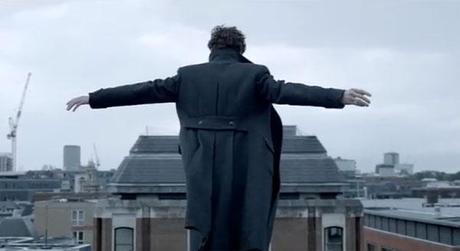
“”It’s a basic truth of the human condition that everybody lies. The only variable is about what. The weird thing about telling someone they’re dying is it tends to focus their priorities. You find out what matters to them. What they’re willing to die for. What they’re willing to lie for.” – Gregory House, “Three Stories.” House
“I may be on the side of the angels…but don’t think for one second that I am one of them.”
-Sherlock Holmes, “The Reichenbach Fall.” Sherlock
By Jonathan Morris, Antiscribe.com
Widely regarded as the greatest, the most influential, and certainly the most popular detective in the history of world literature, Sherlock Holmes and his appeal may just transcend that of the mystery genre itself.
You see, while the best of Sir Arthur Conan Doyle’s Sherlock Holmes stories were excellent mysteries centered on intriguing and compelling deductions, so much of what makes Sherlock Holmes beloved to the point of devotion for so, so many really lies in the character of the man himself. The world’s first, and only, consulting detective has been interpreted and reinterpreted time and time again, with presentations both vast and varied, but what truly makes him so undeniably interesting is that he’s so unlike any other main character you’ll find in the literature of his time, or even of most times since. Holmes typically doesn’t strive to win the love of a girl. He’s not interested in wealth or fame or power. And only on rare occasions does he take a true interest in upholding or protecting the greater good. He eschews relationships, despises romance, and views the righting of wrongs as less a moral imperative than a source of distraction from, at best, boredom, and, at worst, habitual drug abuse.
Despite much of this being pretty common knowledge, it remains an undervalued and unrecognized pleasure in the Holmes experience that he so easily sets aside the things we care about most: the feelings and opinions of others, the need for upward mobility and financial security, and the innate desire we all have to love and be loved. There’s something undeniably seductive about spending time in the life of Sherlock Holmes, a man who, despite always effortlessly absorbing and analyzing every little detail in the world around him, somehow manages to live almost entirely within the comfort his own head.
In recent years, and especially over the last decade, producers, writers, and actors attempting to update Holmes for our newer, more modern, and more easily distracted era have latched on to and amplified the idea of the great detective as a misanthrope: someone who actively detests, despises, or proves utterly indifferent to the human race or the human condition. While Conan Doyle’s works presented Holmes as someone largely asocial because of his unfailing commitment to rationalism, recent adaptations have transformed him further into someone not only asocial but antisocial, changing him from an analytical thinking machine into a complete misanthrope, whose astounding ability to detect and deduce mitigates the ethical qualms we might have about finding someone who’s so ostensibly hateful of others to be just so damn likeable.

A famed statue of Sherlock Holmes erected in Edinburgh, Scotland, the birthplace of his creator, Sir Arthur Conan Doyle.
This month presents an important time for two of the most popular modernizations of Sherlock Holmes in recent years: the BBC series Sherlock and the American medical drama House. As House ends its eight season run as one of the world’s most popular television shows this month, the second series of Sherlock has been airing here in the United States on PBS affiliates across the country (Sherlock’s second season finale debuts stateside on May 20, while the final episode of House airs 24 hours later on May 21). Each series, in its own way, presented its Holmes characters as misanthropes whose despicability to all was only matched by their general ability to detest, or at least be ruthlessly indifferent, to others.
Of course, they hardly represent the first Sherlocks to be this way. Jeremy Brett’s legendarily authentic interpretation, which hit television screens on in Britain and the United States back in 1984, was always, then and now, a revelation, in no small part because his Holmes wasn’t the dashing debonair detective of earlier incarnations, but a sometimes moody, introspective, irreverent eccentric that laid bare the antisocial nature of Conan Doyle’s creation. Robert Downey, Jr.’s recent take on the Great Detective in Guy Ritchie’s two recent blockbusters also downplayed Holmes as an analytical sleuth to present an unkempt, ill-mannered, hard-living basket case who is hated almost as much by his friends as he is by his enemies. What particularly sets House and Sherlock apart from other adaptations, though, comes in the way they explored the very misanthropy that defined their detectives’ personalities, and used it to reemphasize the humanity that defined their characters.
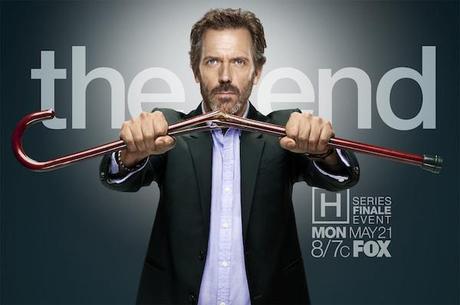
After an amazing eight year run, where it was consistently one of the highest rated shows on television worldwide, “House” ends on May 21, 2012.
House, created by David Shore and Paul Attanasio, took the most unpleasant aspects of the Holmes character’s misanthropy, such as his dependence on drugs and his almost complete lack of human sympathy, amplified them almost to their breaking point, and then combined them all with a very successful combination of biting sarcasm and absorbing pathos. The series related the stories of its eponymous character, Dr. Gregory House, M.D. (in other words, House = Holmes…get it?), a curmudgeonly, quick-witted jerk with no appreciation for the notion of “bedside manner” and who wasn’t above breaking every rule of medical ethics to diagnose and save a patient. While not specifically named as such, House was a very unique and original kind of detective, one not devoted to solving crimes but diagnosing obscure medical disorders in patients by examining symptoms and determining causes. Though it might sound to some to be a boring and mundane premise, in execution it was sometimes brilliant, as the medical afflictions that struck the various patients of the week were typically caused as much by human actions and inactions as by anything pathogenic, just like the crimes that define traditional Sherlock Holmes mysteries.
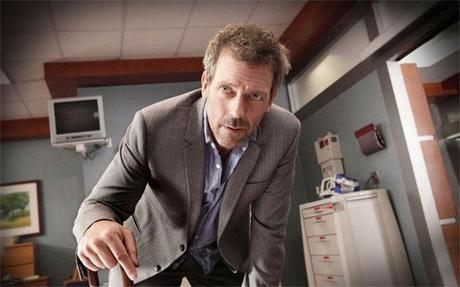
As played by Hugh Laurie, the acerbic Dr. House was not highly regarded for his bedside manner…
As brilliantly played by British Actor and Comedian Hugh Laurie, the American House was very much a modern analog of Sherlock Holmes in not only his amazing deductive brilliance but also in his unabashed misanthropy. In place of Watson, House’s best friend was his fellow doctor James Wilson (Robert Sean Leonard), a good-natured oncologist (cancer doctor) whose compassionate nature was quite nearly the antithesis of House’s. More than just a Watson, though, House, as head of diagnostic medicine at the fictional Princeton-Plainsboro Hospital in New Jersey (it’s clearly fictional because it’s WAY too nice to be a Jersey hospital), was aided by a team of usually younger doctors who performed House’s “heavy lifting” in regards to medical procedures and patient interaction; House’s rotating team of underlings not only proved to be a source of character drama for the series, but provided the show’s writers an ideal way to discuss the issues, ethics, and conundrums at the heart of every episode’s story removed from the scope of House’s often relentless cynicism.
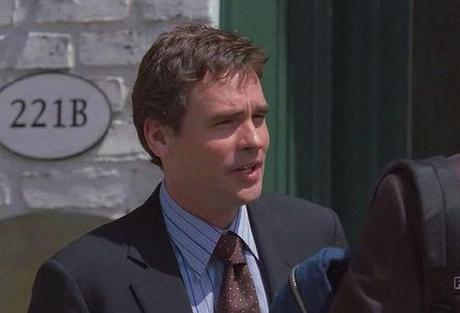
House’s Dr. Watson, Dr. James Wilson (Robert Sean Leonard) standing conspicuously outside House’s apartment.
House himself generally disliked everyone, and his deep-seeded pessimism about the nature of people informed not only his outlook on life, but also his sense of humor. Arguably the best part of the series through its formative years what that it could be downright hilarious, as House was a master of the kinds of quips, one-liners, and put-downs that generally exposed the idiocy and hypocrisy in others while hiding and deflecting much of the internalized pain that defined him as a character. While a Holmes surrogate (right down to a 221B house number), House was still ultimately a separate character, allowing his creators to explore his personality and give him a rich backstory that the real Holmes generally lacked: crippled a few years before the start of the series due to a misdiagnosed infarction in his leg, House walks through life not only with a pronounced limp but in a great deal of pain. Besides spurring a recurring vicodin addiction, the trauma of the experience deeply influenced the character’s world view and fueled his cynicism about people and their motives. Often repeated and reaffirmed on the show, time and again, was House’s deeply cynical mantra that “everybody lies,” and in doing so, willingly sacrifices or maintains their own health or status in the name of preserving a falsehood. Beneath his acrimony, though, House housed a heart of (mostly) gold, and though his need to correctly diagnose a patient was almost as much about his own obsessions as anything, he wasn’t above breaking almost any ethical or moral rule or law short of outright murder to save his patients or to help the people closest to him.
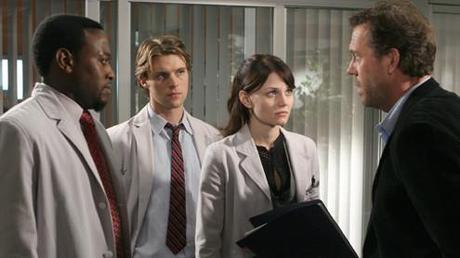
House with the first, and best, of what would be a revolving cast of Doctors in his department: Foreman (Omar Epps), Chase (Jesse Spencer), and Cameron (Jennifer Morrison).
Though it has been a consistent ratings success from its outset, and at one point officially the most popular television show in the world, House has not qualitatively been a perfect show. Though Laurie has always generally been excellent, and notoriously passed over for an Emmy on many occasions, the show has suffered over the years from questionable casting changes, a wavering commitment to its own sense of humor, and an ongoing tension between its general formulaic style and its sometimes hackneyed story arcs. It also must be said that while a little of House the character is never enough, a lot of both show and character could ultimately carry you a long way, and I know a few people like me, who eventually gave up on the show because the cynicism of the character and his world became just a little too exhausting. With that said, I will most definitely be watching House take “his last bow” this Monday, and if the finale of the show arguably came a little too late in the its run, I can’t help but feel that this Monday will somehow be coming a little too soon.
http://www.youtube.com/watch?v=sFG79agEkyw
If being too much of a good thing had been an issue with House, the BBC series Sherlock, created by Steven Moffatt, of Doctor Who and Coupling fame, and Mark Gatiss, has mainly been defined by the notion that absence makes the heart grow fonder. Since its debut in 2010, Sherlock has only had two series (seasons), consisting of only three ninety-minute episodes each, with a lag between the first and second series of almost a year and a half (!). The wait, as it was, was made all the more agonizing by the fact that the first series ended on a cliffhanger, with the modern incarnation of the great detective (Benedict Cumberbatch) and his Watson (Martin Freeman) finally confronted by the former’s nemesis: the master criminal Jim Moriarty (Andrew Scott), who, it seemed, had the opportunity in to murder the Great Detective and the Good Doctor once and for all…
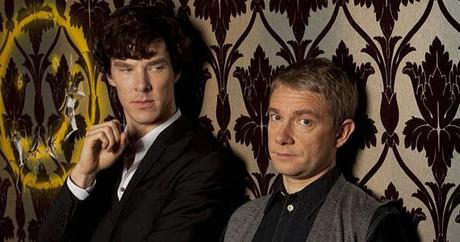
Clearly though, Sherlock (Benedict Cumberbatch) and John (Martin Freeman), lived to sleuth another day.
Sherlock may appear at first glance as simply the latest in a particular trend of antisocial Holmeses after House and the recent Sherlock Holmes films, and that’s partially true. In truth, though, the series serves almost as the culmination of the Holmes character’s modern turn towards misanthropy, and a great deal of the show’s triumph in its second season lies in the way it not only lets the audience share in the vicarious pleasures of Holmes’s often viciously antisocial attitude, but almost turns that appeal against itself by allowing Holmes to begin realizing that it may not be Moriarty who’s his worst enemy, but himself.
Sherlock, for the uninitiated, is a retelling of the Holmes mythology told within the present day era of smart phones, net books, social networks, Wi-Fi, GPS, forensic medicine, and other hot technologies; but while the modern world in which this Holmes lives may differ from the one that informed Conan Doyle’s stories, Sherlock emphasizes wonderfully how little of the character’s appeal has actually changed in more than a century. Dr. John Watson, when introduced in the first season, is a veteran of the War in Afghanistan whose addiction to the rush of action and excitement makes him fast friends with his new flatmate: the otherwise thoroughly aloof Sherlock Holmes, a consulting detective occasionally brought in by Scotland Yard’s D.I. Lestrade (Rupert Graves) to help with cases that the police can’t solve. Sherlock is, by his own admission, a thoroughly antisocial personality and even labels himself “a high functioning sociopath” and John, who becomes his official biographer blogger, is not just his only real friend in the world but sometimes something of his handler. Of course, due to modern sensibilities, almost everyone who meets them assumes right off the bat that they’re a couple; and in many respects, they are. As the second season begins, the misanthropic Sherlock, thanks to Watson’s online chronicles of his adventures, has emerged from obscurity to become a completely unwilling Internet celebrity.
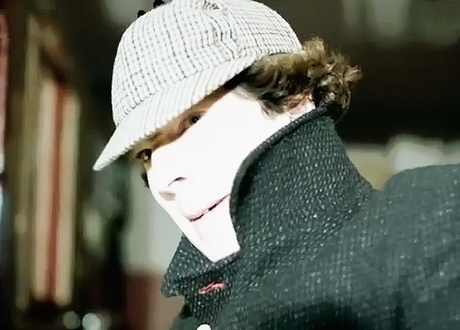
“The Sherlock Hat” – A major storyline in the second series involves Sherlock becoming an Internet celebrity; which, much to his consternation, involves this picture of him wearing a deerstalker hat becoming a meme.
While House used the Sherlock ethos as an inspiration for its character, Sherlock is naturally more explicit in its fidelity to Conan Doyle. The episodes, though, are not straight adaptations of the original stories; while each one centers predominantly on one of the more famous tales, the narratives themselves are constructed on a sampled bricolage of many different Conan Doyle stories as well as homages to other famous interpretations of the great detective. In short, Sherlock is a postmodernist’s field day. The second series, like the first, consists of three ninety-minute episodes, and like the first series followed a set trend: the first episode was great, the third was amazing, and the middle one proved to be somewhat underwhelming.
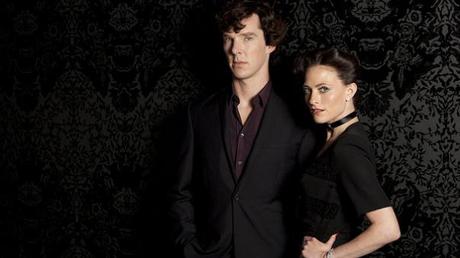
“A Scandal in Belgravia” involves Sherlock coming face to face with one his most famous foes – the seductive Irene Adler (Lara Pulver).
The first episode, “A Scandal in Belgravia” adapts the famous Holmes story “A Scandal in Bohemia,” which introduced the only woman to capture Holmes’s heart and one the only people to ever outsmart him: the blackmailer Irene Adler. Of course, in Sherlock’s modern updating, Irene Adler (Lara Pulver) has gone from being the operatic contralto and part-time courtesan of Conan Doyle’s story to being a bisexual dominatrix for the wealthy and powerful. While dealing with his earliest frustrations with celebrity status, Sherlock is recruited by his brother Mycroft, a powerful government official, to obtain compromising digital photographs Adler has of one of the royal family. Adler, of course, proves to be more than a match for Holmes, and enter into a contest of wills, emotions, frustrations, and flirtations as Adler preyed on Holmes’s inherent loneliness (and his inferred virginity) while Holmes tries to ferret out the larger conspiracy behind Adler’s blackmail plot. In the end, the episode was proved to be something of a remake of Billy Wilder’s classic film The Private Life of Sherlock Holmes, and provided an excellent payoff to fans who had waited an inordinately long time for the new episode.

Sherlock and John enjoying the atmospheric scenery on the moors of Dartmoor in “The Hounds of Baskerville.”
The second episode “The Hounds of Baskerville,” adapted from the most famous and most oft-read Holmes story, was largely unremarkable stuff, with a mystery whose final solution kind of strained credulity (that was actually an issue with all of the episodes this year, but this was where it was the most egregious). Just as in the original, Holmes and Watson are called to Dartmoor to investigate sightings of a mysterious gigantic hell hound and just as with all of the episodes, things have been heavily modernized: “Baskerville” is now a military facility, the Grimpen Mire is now the Grimpen Minefield, and Sir Henry is now Henry Knight. Of all episodes of the series to date, however, this was the one where the modernization not only didn’t improve on the original story but fell far short of it. Still, the awesome and humorous interplay and character development between Sherlock and John elevated it a great deal.
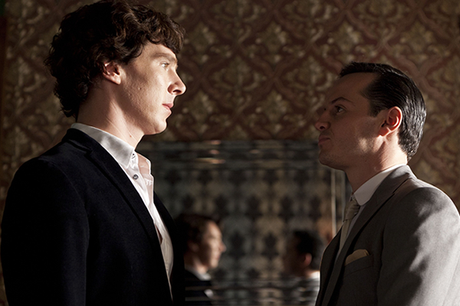
In “The Reichenbach Fall,” Sherlock and nemesis Jim Moriarty engage in their “final problem,” which will see the villain attack the antisocial Sherlock on both a public and private level.
Finally, saving the best for last, “The Reichenbach Fall” updated “The Final Problem” and builds up to the final epic confrontation between Sherlock and the diabolical Jim Moriarty. More than simply looking to defeat Holmes, Moriarty tries to destroy everything Holmes has come to represent as a public figure and private person, and in the process uses Sherlock’s own antisocial behavior and disreputable reputation as a weapon against him. In the end, though, the misanthropic Sherlock is forced by the criminal mastermind into making a choice between saving himself or saving the people most important to him. More than that, I dare not give away…certainly, anyone who knows the outcome of “The Final Problem” may have a vague idea of what happens, but in “The Reichenbach Fall,” that’s really just the tip of the iceberg.
In essence, that sums up a great deal of the appeal of Sherlock as a series: not only is it a fresh, (post)modern take on a timeless character for the uninitiated, but for fans of Conan Doyle the show provides a new and fascinating presentation of old material in an invigorating new light. At the center of it is still Holmes, with his personality mostly faithful to his original counterpart, but presented as a character defined more by his flaws and quirks than the better angels of his nature. With Cumberbatch’s star on the rise due to the series and Freeman likely to blow up thanks to the release of Peter Jackson’s The Hobbit later this year, it may be a long time before we’ll see another season of Sherlock (and most reports are that said season will be the last), but what we’ve received, nevertheless, has been pretty special.
Even though House is going away forever and Sherlock will only feel like it is, the misanthropic Holmes will certainly be with us for some time to come. Guy Ritchie and Robert Downey, Jr. will be making another Sherlock Holmes film (unfortunately), and CBS, seeing the success of Sherlock has been developing its own modern day Sherlock Holmes series, called Elementary. The new show will star Jonny Lee Miller as Holmes and Lucy Liu as a female Watson and will apparently be more direct adaptations of the Conan Doyle stories than Sherlock. Personally speaking, I’m not optimistic about its potential; if anything, I would most be intrigued if the next great Holmes was actually a woman. It’s always easier to portray men as misanthropists; a woman portrayed as a Holmesian genius and maladroit would not only be much more daring, but much more fascinating. Unfortunately, given the prevalence of double standards in popular entertainment, that scenario may be a long, long way off.
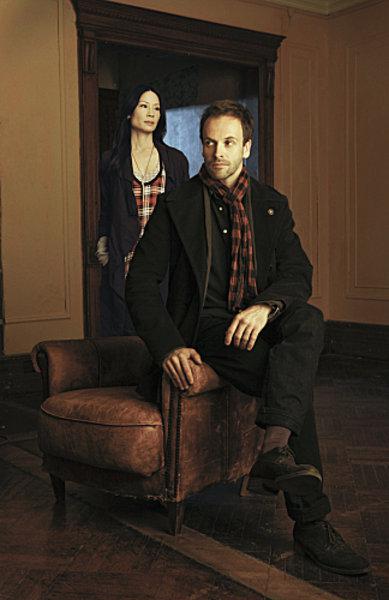
“Elementary” – You don’t have to be a brilliant detective to see that this show has “disaster” written all over it.
Still, why has the modern Holmes been the misanthropic Holmes? Is it just the mischievous appeal and antisocial humor that we secretly desire to vicariously live through? Perhaps so, or perhaps it’s just the latest way the purveyors of popular culture have found to be the easiest way to portray an old character in a new way. I think, though, that as both House and Sherlock have demonstrated, it’s the misanthropy that defines Holmes that strangely also makes him seem the most human of all of popular fiction’s great detectives. After all, to really, truly hate the human race, one first has to be a part of it.
For readers in the United States, the latest three episodes of Sherlock can be watched on PBS.org through June 19, 2012 here.

